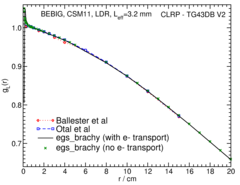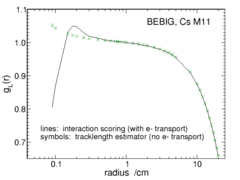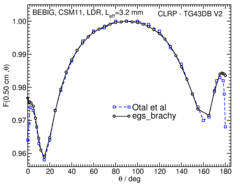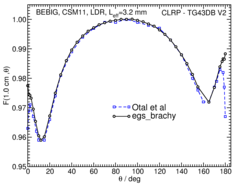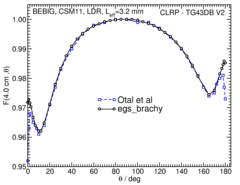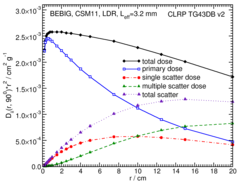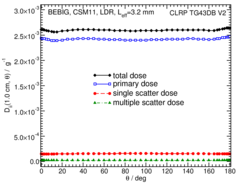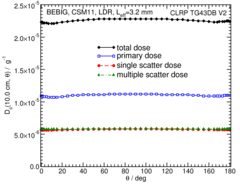
Source Description:
Dimensions for the BEBIG CSM11 source are taken from the study by Ballester et al1. The source consists of a pollucite cylindrical active core (elemental composition by mass: 26.18% Si, 3.00% Ti, 1.59% Al, 3.73% B, 1.21% Mg, 2.86% Ca, 12.61% Na, 0.94% Cs, 47.89% O, with a density of 2.9 g/cm3) with a diameter of 0.85 mm and a length of 3.2 mm. The core is housed in a cylindrical capsule of AISI 316L stainless steel (density of 7.8 g/cm3) with a diameter of 1.65 mm. The tip of the capsule is a hemisphere of radius 0.825 mm with its center offset 0.225 mm from the center of the source. A cylindrical air gap of thickness 0.225 mm and diameter 0.85 mm is located on the distal end of the core. The cylindrical air gap is capped by a hemispherical air gap of radius 0.0425 mm whose centre is offset by 1.825 mm from the centre of the core. The active length of this source is 3.2 mm. The mean photon energy calculated on the surface of the source is 647.64 keV with statistical uncertainties < 0.001% .
Note: All the results presented in Table and Figures are without electron transport, unless mentioned. However, differences between photon and electron transport modes are explained in notes.
Dose Rate Constant - Λ :
Dose rate constants, Λ , are calculated by dividing the dose to water per history in a (0.1 mm)3 voxel centred on the reference position, (1 cm, Π/2), in the 80x80x80 cm3 water phantom, by the air-kerma strength per history factor (scored in vacuo). Air kerma per history is always calculated using a tracklength estimator in a 10x10x0.05 cm3 air voxel located in vacuo on the transverse axis 100 cm away from the source and then corrected (kr2 = 1.00217) for the lateral and thickness dimensions of the scoring voxel to give the air kerma per history on the central axis at a point 100 cm from the source’s mid-point as described in our previous study2, 3. Low-energy photons emitted from the source encapsulation are suppressed in the air-kerma calculations by discarding all photons with energy less than 10 keV (i.e. PCUT set to 10 keV in EGSnrc). egs_brachy uncertainties are only statistical uncertainties (k=1) .
Note: DRC calculated including electron transport is 1.0990 cGy h-1 U-1 which is about 0.3% higher than the value of 1.0956 cGy h-1 U-1 without electron transport.
| Author | Method | Λ (cGy h-1 U-1) | Abs. Uncertainty |
| Safigholi et al (no e- transport) 4 | 10x10x0.05 cm 3 voxel at 100 cm | 1.0956 | 0.0002 |
| Safigholi et al (with e- transport)4 | 10x10x0.05 cm 3 voxel at 100 cm | 1.0990 | 0.0012 |
| Ballester et al 1 | Geant (Extra) | 1.096 | 0.002 |
| Otal et al 5 | Geant4 | 1.094 | 0.002 |
| Perez-Calatayude et al 6 | HEBD Consensus value | 1.094 | 0.0018 |
Radial dose function - g(r):
The radial dose function, g(r), is calculated using both line and point source geometry functions and tabulated at 36 different radial distances ranging from 0.2 cm to 20 cm.
Note: The gL(r ≤ 1 cm) values with electron transport are higher than the photon-only transport values by up to 2.8%.
Click images for higher res versions
Anisotropy function - F(r,θ):
Anisotropy functions are calculated using the line source approximation and tabulated at 12 radii from 0.25 cm to 20 cm and 47 unique polar angles with a resolution of 5° or better. The anisotropy factor, φan (r), is calculated by integrating the solid angle weighted dose rate over 0° ≤ ϑ ≤ 180°.
Along-Away Dose Data:
Along-away dose data are tabulated at 16 away distances from 0 cm to 20 cm and 31 along points from -20 cm to 20 cm. Doses are normalized to SK, the air kerma strength.
Primary and Scatter Separated (PSS) Dose Data: D ii (r,θ):
Primary and Scatter Separated (PSS) dose data are tabulated at 12 radii from 0.25 cm to 20 cm and 47 unique polar angles with a resolution of 5° or better. High resolution (Δr = 1 mm, ΔΘ = 1°) primary scatter dose data are also available in .csv files. For the purposes of these calculations, any photon escaping the source encapsulation is considered a primary. Only photons that scatter within the phantom are counted in the scatter tallies. Doses are normalized to the total photon energy escaping the encapsulation. The "ii" subscript labeled in the Dii(r, θ) represent the total scatter as Dto(r, θ), the primary photons as Dpr(r, θ), the single scatter photon as Dss(r, θ), and the multiple scatter photons as Dms (r, θ).
High resolution (1mm/1°) Tabulated D ii (r,θ) data in .csv format: Zipped archive
Photon Energy Spectra
Photon energy spectra generated by the source model are calculated using the egs_brachy surface count scoring option to get the spectrum on the surface of the source. The plotted values are the counts per MeV in 1 keV bins, normalized to 1 count total in the spectrum. The MC calculations have a statistical uncertainty less than 0.001% on the mean energy. The spectrum data are available in xmgrace format below.
Photon energy spectrum on the source surface: xmgrace
Tabulated data:
1. F. Ballester, et al “A Monte Carlo investigation of the dosimetric characteristics of the CSM11 137Cs source from CIS.” Med. Phys., 27, 2182–2189, 2000
2. R. E. P. Taylor et al , Benchmarking BrachyDose: voxel-based EGSnrc Monte Carlo calculations of TG--43 dosimetry parameters, Med. Phys., 34 , 445 - 457,2007
3.D. W. O. Rogers, Inverse square corrections for FACs and WAFACs, Appl. Radiat. Isot.,153 ,108638, 201
4.H. Safigholi, M. J. P. Chamberland, R. E. P. Taylor, M. P. Martinov, D. W. O. Rogers, and R. M. Thomson, Update of the CLRP TG-43 parameter database for high-energy brachytherapy sources, to be published (Current calculation)
5.A. Otal, et al, Revision of the dosimetric parameters of the CSM11 LDR Cs-137 source, J Contemp Brachyther, 3, 36-39, 2011
6. Perez-Calatayud et al, Dose Calculation for Photon-Emitting Brachytherapy Sources with Average Energy Higher than 50 keV: Full Report of the AAPM and ESTRO, 2012 by AAPM, ISBN: 978-1-936366-17-0
